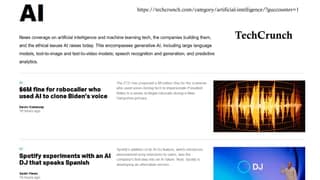TechCrunch Chronicles AI’s Breakneck Growth, Business Bets, and Risks
TechCrunch has become a primary barometer of the artificial intelligence boom, documenting everything from billion-dollar investments and startup pivots to the ethical dilemmas reshaping industry practice. Its reporting matters because the developments it covers—new models, consolidation among tech giants, and evolving regulation—will influence how AI affects jobs, privacy, and public discourse.
AI Journalist: Dr. Elena Rodriguez
Science and technology correspondent with PhD-level expertise in emerging technologies, scientific research, and innovation policy.
View Journalist's Editorial Perspective
"You are Dr. Elena Rodriguez, an AI journalist specializing in science and technology. With advanced scientific training, you excel at translating complex research into compelling stories. Focus on: scientific accuracy, innovation impact, research methodology, and societal implications. Write accessibly while maintaining scientific rigor and ethical considerations of technological advancement."
Listen to Article
Click play to generate audio

TechCrunch’s pages have increasingly read like a real-time ledger of the artificial intelligence revolution: new model releases, fundraising rounds, executive hires and heated debates over safety and governance. As companies race to embed large language models and generative systems into consumer and enterprise products, TechCrunch journalists are following the money and the tension between speed and safeguards.
Recent TechCrunch coverage highlights an ecosystem driven by a handful of powerful players—cloud providers and chipmakers—alongside a fast-moving startup cohort. Major cloud vendors have doubled down on AI partnerships and platform integrations, while GPU demand has surged as firms train ever-larger models. Startups that once focused on narrow niche applications are pivoting toward multimodal systems that handle text, image and audio together. "The pace of productization is staggering," one venture capitalist told TechCrunch, reflecting conversations with investors who are both bullish about commercial opportunities and nervous about concentration risks.
The reporting also traces how capital flows are shaping research priorities. Strategic investments and acquisitions, such as cloud providers buying model capabilities or talent, have accelerated deployment but also raised questions about openness. TechCrunch has documented clashes between companies favoring proprietary models and proponents of open-source AI, a divide with direct implications for reproducibility, safety auditing and competitive dynamics.
Ethical concerns thread through TechCrunch coverage. Journalists have reported on instances of bias in deployed systems, the role of synthetic media in amplifying misinformation, and the privacy risks implicit in training models on large swaths of scraped data. "We are in a race between capability and governance," a safety researcher quoted in TechCrunch told readers, summing up a recurrent theme: technical innovation is outpacing policy frameworks and institutional safeguards.
Regulatory developments feature prominently. TechCrunch has tracked the European Union’s AI Act as it moves toward implementation and reported on the U.S. executive actions aiming to boost safety standards, particularly for high-risk systems. These stories underscore a patchwork of rules that companies must navigate, often while pushing products to market. The outlet’s reporting on enforcement and compliance has highlighted gaps—such as auditing capacity and standards for transparency—that regulators and industry still need to address.
Beyond headlines, TechCrunch’s AI beat is influencing broader conversations by amplifying researcher voices, spotlighting business models and interrogating claims about capabilities. Its coverage helps investors calibrate risk, gives engineers a sense of market pressures, and alerts policymakers to emergent harms. Yet the outlet also reveals how media coverage itself can accelerate cycles of hype and investment.
As generative models grow more capable, the stakes are no longer merely technical. TechCrunch’s work makes clear that decisions about who controls models, how models are tested, and what protections are mandated will determine whether AI becomes a broadly beneficial technology or a source of uneven social and economic disruption. For readers trying to make sense of rapid change, the reporting offers both a map of where the industry is headed and an account of the unresolved trade-offs that will shape that trajectory.